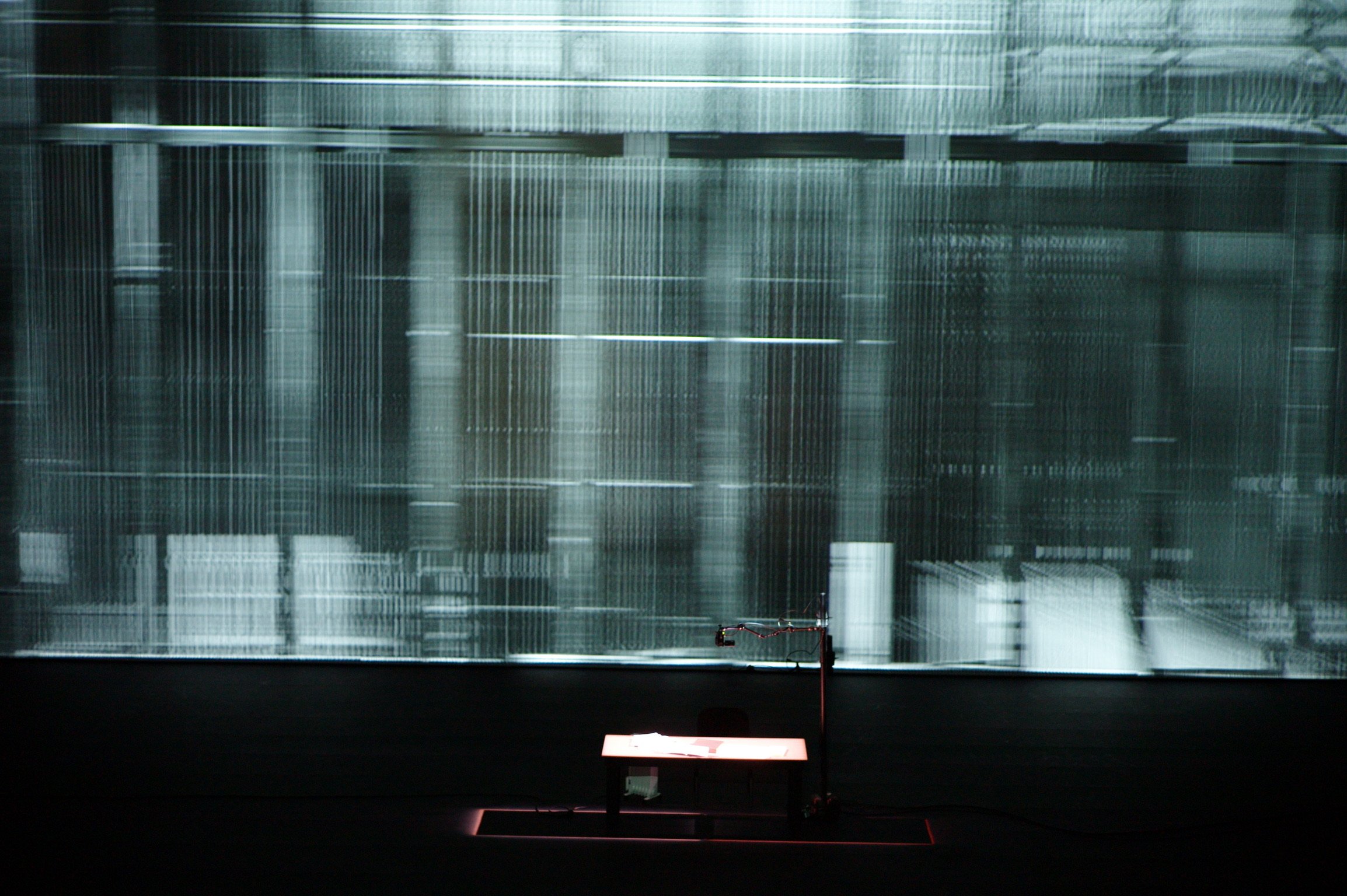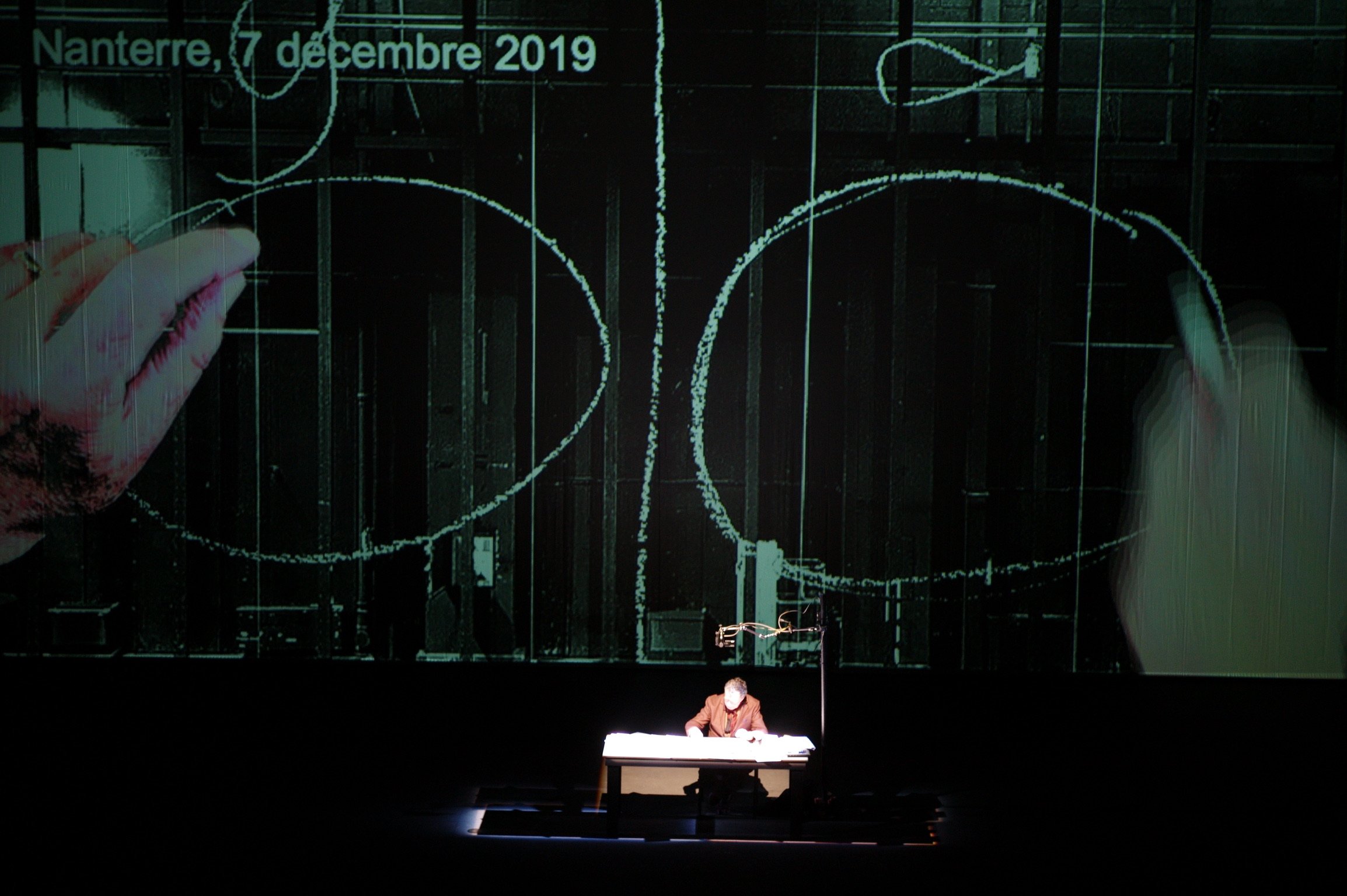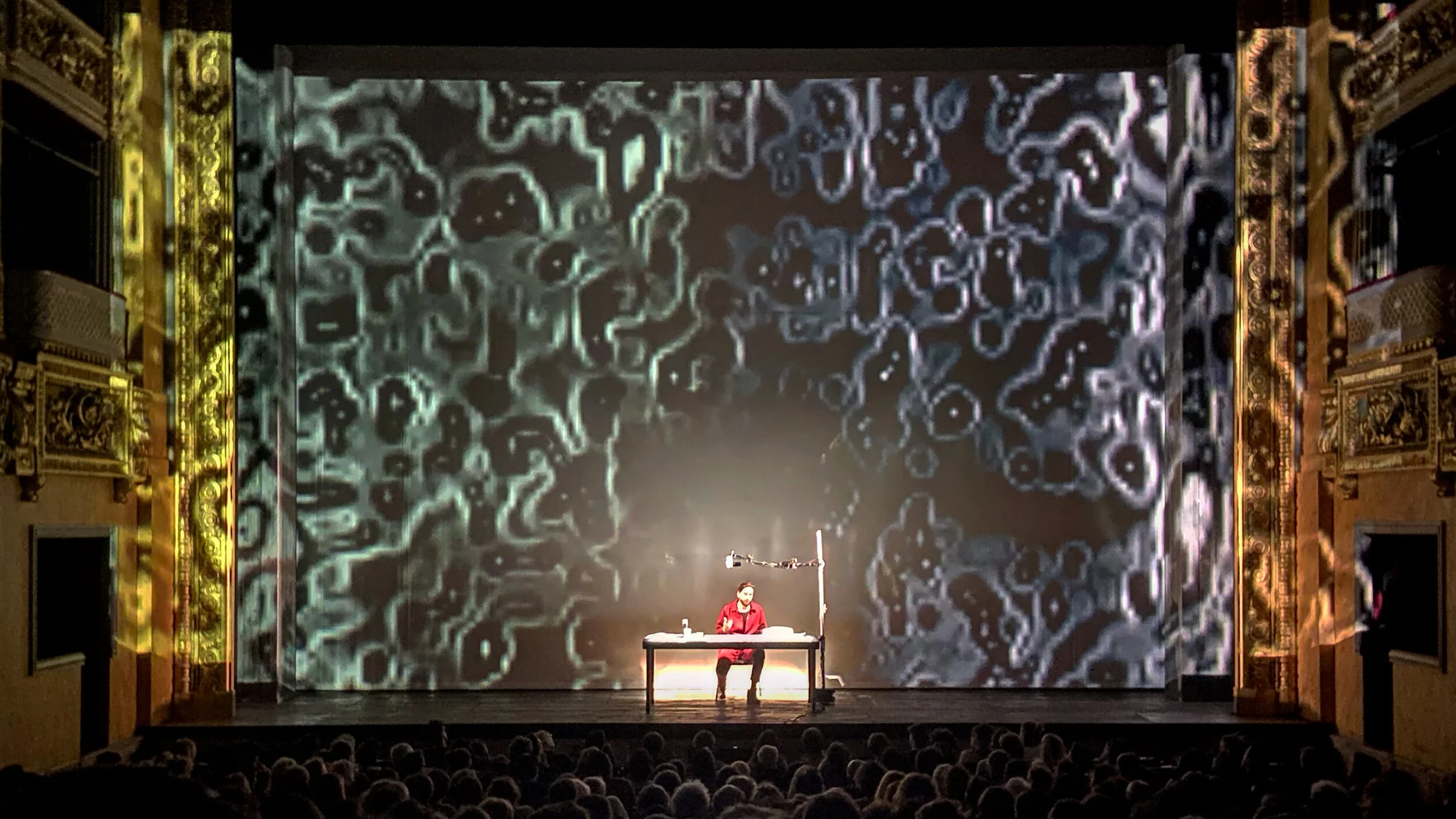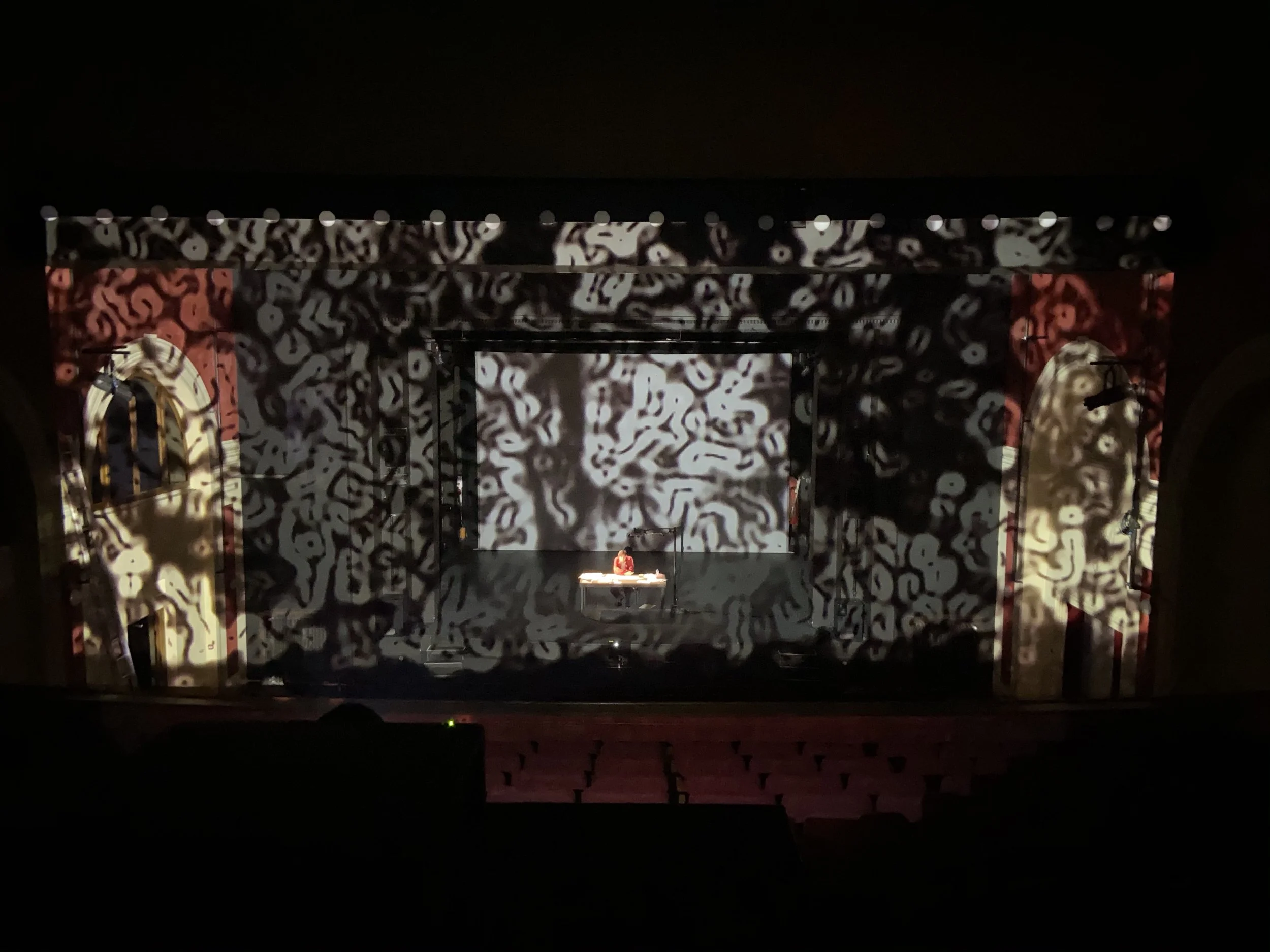Moving Earths
Moving Earths, de Bruno Latour et Frédérique Aït-Touati, mêle théâtre, science et philosophie pour explorer notre relation à une planète en mouvement. J’ai conçu une scénographie adaptable, où les projections débordent les limites, transformant les espaces et immergeant le public dans la complexité des idées de Latour sur l’Anthropocène.
Moving Earths, by Bruno Latour and Frédérique Aït-Touati, blends theater, science, and philosophy to explore our relationship with a planet in motion. I created an adaptable scenography where projections transcend boundaries, transforming spaces and immersing audiences in the complexity of Latour’s ideas on the Anthropocene.
-
Moving Earths, écrit par Bruno Latour et mis en scène par Frédérique Aït-Touati, s’inscrit dans la continuité d’un dialogue entre théâtre, science et philosophie. Inspirée par la révolution copernicienne et les travaux contemporains sur l’Anthropocène, cette conférence-performance questionne notre rapport à une Terre en mouvement : comment percevoir un monde en perpétuel changement, secoué par des crises écologiques et climatiques sans précédent ?
Le projet a commencé autour de la table de salle à manger de Bruno Latour, un espace où la réflexion, les échanges et les gestes de travail prenaient toute leur ampleur. Cette table, ancrée dans le quotidien et la pensée, a inspiré la scénographie et le dispositif scénique. Lors des répétitions au grand plateau de Nanterre-Amandiers, le dispositif initial exploitait les possibilités des cintres pour cadrer et recadrer les projections à l’aide de frises mobiles, traduisant visuellement la construction et la déconstruction des représentations du monde.
Mais le passage à la salle transformable a imposé une reconfiguration majeure. Sans la possibilité des frises et des jeux de cadres suspendus, j’ai dû repenser ces principes de cadrage autrement. J’ai imaginé un dispositif où l’image ne se limiterait plus à un écran unique, mais pourrait déborder, s’étendre, et envahir l’espace. Les projections, libérées de leurs frontières, ont commencé à gagner les premiers rangs du public, intégrant l’espace scénique et son environnement immédiat. Ce débordement visuel a permis de prolonger les idées de Bruno, qui interrogeaient déjà nos manières de représenter et de percevoir la Terre.
Les projections ne sont pas simplement des decors : elles deviennent des actrices, transformant l’espace et jouant avec les échelles pour faire dialoguer l’infiniment petit et l’infiniment grand. Inspirées par des cartographies, des graphiques et des images documentaires, ces projections interagissent avec les gestes et les déplacements de Bruno sur scène. Ce dispositif rend palpable la richesse de sa pensée, tout en permettant au spectateur de naviguer librement dans un univers en transformation.
Cette réinvention s’inscrit également dans une démarche de conception raisonnée, essentielle à mon approche. Chaque espace scénique en tournée a nécessité une adaptation, non seulement aux contraintes techniques, mais aussi aux spécificités des lieux et aux ressources locales. Cela a permis de minimiser l’impact logistique tout en exploitant pleinement l’intelligence des équipes techniques locales, transformant chaque représentation en une expérience singulière.
Moving Earths est plus qu’une conférence-performance : c’est une invitation à penser le “terrestre” autrement, à travers la lumière, les projections, et le mouvement. En revisitant constamment ses propres principes scénographiques, le projet s’est enrichi de chaque contrainte, traduisant la complexité de la pensée de Bruno Latour dans une expérience scénique sensible et immersive. Les débordements visuels, les jeux d’échelle, et les interactions entre l’espace et le public reflètent l’urgence et la profondeur des questions soulevées par cette œuvre hybride.
-
Moving Earths
Moving Earths, written by Bruno Latour and directed by Frédérique Aït-Touati, continues the dialogue between theater, science, and philosophy. Inspired by the Copernican revolution and contemporary research on the Anthropocene, this performance-lecture explores our relationship with an ever-changing Earth: how can we perceive a world in constant flux, shaken by unprecedented ecological and climatic crises?
The project began around Bruno Latour’s dining table, a space where reflection, dialogue, and gestures of work took shape. This table, rooted in both everyday life and intellectual inquiry, inspired the scenography and stage design. During rehearsals on the main stage at Nanterre-Amandiers, the initial setup leveraged the fly system to frame and reframe projections using movable borders, visually embodying the construction and deconstruction of worldviews.
However, the transition to a transformable venue required a significant reconfiguration. Without the possibility of suspended borders and framing devices, I had to rethink these principles of framing in new ways. I devised a setup where imagery was no longer confined to a single screen but could spill over, expand, and invade the space. Projections, freed from their boundaries, began to reach into the first rows of the audience, integrating the stage and its immediate surroundings. This visual overflow extended Bruno’s ideas, which already challenged how we represent and perceive the Earth.
The projections are not mere backdrops: they act as performers themselves, transforming the space and engaging with scales that oscillate between the microscopic and the vast. Drawing from cartography, graphs, and documentary imagery, these projections interact with Bruno’s gestures and movements on stage. This setup makes his complex ideas tangible, inviting the audience to navigate freely through a world in transformation.
This reinvention aligns with a reasoned design philosophy that is central to my approach. Each touring venue required adaptation, not only to technical constraints but also to the unique characteristics and resources of the spaces. This minimized logistical impact while fully utilizing the expertise of local technical teams, transforming each performance into a singular experience.
Moving Earths is more than a performance-lecture: it is an invitation to rethink the “terrestrial” through light, projections, and movement. By continuously revisiting its scenographic principles, the project has grown richer with each challenge, translating Bruno Latour’s intricate thinking into a sensitive and immersive stage experience. The visual spillovers, shifting scales, and interactions between space and audience reflect the urgency and depth of the questions raised by this hybrid work.
-
Titre de l’œuvre : Moving Earths
Année : 2019 (Création)
Crédits :
• Texte et concept : Bruno Latour et Frédérique Aït-Touati
• Mise en scène : Frédérique Aït-Touati
• Scénographie, lumière, vidéo et animations : Patrick Laffont de Lojo
• Interprétation : Bruno Latour (création), Duncan Evennou (reprises et tournées)
Médium : Performance intégrant projections vidéo, son, et mise en espace
Matériaux :
• Table centrale intégrée au dispositif scénique, supportant manipulations graphiques et documents en direct
• Projections vidéo, intégrant des cartographies, graphiques scientifiques et animations
• Dispositifs lumineux et vidéographiques jouant sur les échelles et la spatialité
Description :
Moving Earths explore deux grandes révolutions scientifiques : la révolution copernicienne, qui a déplacé la Terre du centre de l’univers, et la révolution gaïenne, inspirée par les travaux de James Lovelock et Lynn Margulis, qui conceptualise Gaia comme un système vivant et autorégulé. Cette conférence-performance interroge les liens entre théâtre, science, et philosophie en rendant perceptible l’idée d’une Terre vivante, en perpétuel mouvement.
Le dispositif scénique conçu par Patrick Laffont de Lojo met en lumière des projections qui débordent de l’écran pour occuper tout l’espace, jouant avec les échelles et créant un dialogue entre la scène et le public. Ces éléments traduisent visuellement la complexité des concepts exposés, offrant une expérience immersive qui fait écho aux bouleversements de notre compréhension de la Terre.
Représentations et adaptations :
Création : Théâtre Nanterre-Amandiers, Nanterre, France (7 décembre 2019)
Autres représentations :
• Centre Pompidou, Paris, France (21 janvier 2019 – BACK TO EARTHS - Préfiguration, Festival Hors-Pistes)
• Hans Rausing Lecture, Uppsala University, Suède (14 octobre 2019)
• Théâtre de l’Odéon, Paris, France (20 janvier 2020)
• Collège des Bernardins, Paris, France (6 février 2020)
• Down to Earth – Berliner Festspiele, Gropius Bau, Berlin, Allemagne (13 août – 13 septembre 2020 – Version unplugged)
• Mosteiro de Tibães, Braga, Portugal (21 mai 2022 – Adaptation unplugged)
• Festival de Marseille, Théâtre de la Criée, Marseille, France (28 juin 2021)
• BOCA Biennal of Contemporary Arts, Lisbonne, Portugal (13 octobre 2021)
• NYU Shanghai, Chine (28 août 2024 – Version filmique)
Commande et production :
• Commande : Théâtre Nanterre-Amandiers
• Production originale : Zone Critique
• Coproduction : Théâtre Nanterre-Amandiers, Centre Pompidou
Soutiens :
• Fonds [N.A!]
• Fondation Carasso
• DICRéAM
-
Title of the Work: Moving Earths
Year: 2019 (Creation)
Credits:
• Text and Concept: Bruno Latour and Frédérique Aït-Touati
• Direction: Frédérique Aït-Touati
• Scenography, Lighting, Video, and Animations: Patrick Laffont de Lojo
• Performance: Bruno Latour (creation), Duncan Evennou (subsequent performances and tours)
Medium: Performance integrating video projections, sound, and spatial design
Materials:
• Central table integrated into the stage setup, supporting real-time manipulations of graphics and documents
• Video projections, including maps, scientific graphics, and animations
• Lighting and videographic systems designed to explore spatiality and scale
Description:
Moving Earths examines two major scientific revolutions: the Copernican revolution, which displaced Earth from the center of the universe, and the Gaia hypothesis, pioneered by James Lovelock and Lynn Margulis, conceptualizing Earth as a living, self-regulating system. This performance explores the connections between theater, science, and philosophy, making the idea of a living, ever-changing Earth perceptible to the audience.
The stage design by Patrick Laffont de Lojo highlights projections that extend beyond the screen to occupy the entire space, playing with scales and creating a dialogue between the stage and the audience. These elements visually translate the complexity of the concepts, offering an immersive experience that resonates with the shifts in our understanding of Earth.
Performances and Adaptations:
Creation: Théâtre Nanterre-Amandiers, Nanterre, France (December 7, 2019)
Other Performances:
• Centre Pompidou, Paris, France (January 21, 2019 – BACK TO EARTHS – Prefiguration, Festival Hors-Pistes)
• Hans Rausing Lecture, Uppsala University, Sweden (October 14, 2019)
• Théâtre de l’Odéon, Paris, France (January 20, 2020)
• Collège des Bernardins, Paris, France (February 6, 2020)
• Down to Earth – Berliner Festspiele, Gropius Bau, Berlin, Germany (August 13–September 13, 2020 – Unplugged Version)
• Mosteiro de Tibães, Braga, Portugal (May 21, 2022 – Unplugged Adaptation)
• Festival de Marseille, Théâtre de la Criée, Marseille, France (June 28, 2021)
• BOCA Biennal of Contemporary Arts, Lisbon, Portugal (October 13, 2021)
• NYU Shanghai, China (August 28, 2024 – Film version)
Commission and Production:
• Commission: Théâtre Nanterre-Amandiers
• Original Production: Zone Critique
• Co-production: Théâtre Nanterre-Amandiers, Centre Pompidou
Support:
• Fonds [N.A!]
• Fondation Carasso
• DICRéAM

















